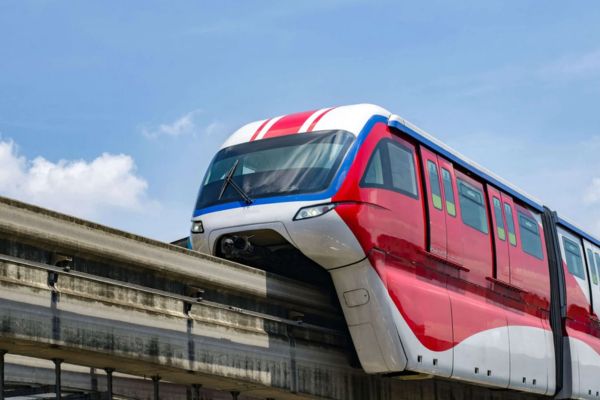The global urban air mobility market size is expected to reach around USD 41.87 billion by 2033 from USD 5.41 billion in 2024 and is expanding at a CAGR of 25.52% from 2024 to 2033.
With rapid urbanization, increasing traffic congestion, and growing populations in metropolitan areas, the demand for alternative transportation solutions is rising. Urban Air Mobility (UAM) offers a promising response by introducing faster, more direct aerial routes that help alleviate pressure on overloaded ground infrastructure. UAM is emerging as a viable option for city planners and developers seeking to enhance mobility and reshape urban transport systems.
UAM in Action
Inspired by rideshare models, new business opportunities are emerging around air taxi services for urban commuters. Electric Vertical Takeoff and Landing (eVTOL) aircraft are at the forefront, also showing potential in last-mile logistics and urban cargo delivery.
Also known as Advanced Air Mobility (AAM), UAM envisions an air transport ecosystem that is accessible, safe, economical, and sustainable—designed for moving people, delivering goods, and managing emergencies in densely populated areas. As part of a broader on-demand mobility network, UAM integrates seamlessly with other transport modes like public transit, shared vehicles, and courier services.
Cities like Singapore, Dubai, Dallas, and Los Angeles are leading the way, actively piloting UAM initiatives to relieve stress on congested infrastructures.
Addressing Congestion
Traffic congestion wastes time, fuel, and productivity, negatively impacting urban economies. UAM offers a compelling solution by using low-altitude airspace to bypass crowded streets, reducing travel times and easing pressure on road systems. VTOL aircraft can operate from rooftops or vertiports, making them ideal for dense urban areas with limited space.
Incorporating UAM into multimodal city transport strategies can help create a more connected, efficient system. For example, Joby Aviation is developing eVTOL aircraft designed for point-to-point urban travel, offering a sustainable, high-speed alternative.
Key Market Insights (2023):
- North America led the UAM market with a 39.84% share.
- Europe followed with 30.27% of the market.
- By component, hardware accounted for 60% of revenues, while software contributed 40%.
Urban Air Mobility Market Dynamics
Market Drivers
1. Urban Congestion
UAM provides a way around overloaded road networks by utilizing vertical lift aircraft to offer fast, efficient travel, particularly in high-density cities. This helps improve overall urban mobility and access, especially in underserved areas.
2. Demand for Shorter Commutes
As cities grow, so do commute times. UAM addresses this by offering direct, traffic-free transport. For instance, in 2024, Miami launched a pilot program connecting downtown to the airport via air taxis, reducing travel time from 45 minutes to just 10.
Market Restraints
High Initial Investment
UAM development demands significant capital for R&D, aircraft manufacturing, infrastructure (like vertiports and charging stations), and regulatory compliance. These barriers can limit participation by smaller companies and slow innovation.
An example is Joby Aviation, which despite large investments, has faced challenges in scaling operations due to regulatory and funding hurdles.
Opportunities
Increased Demand for Efficiency
With urban sprawl and longer commutes, there’s growing interest in quicker, more efficient transportation. UAM answers this call with rapid, point-to-point air travel, helping reduce congestion and improve quality of life.
Key Challenges
Cybersecurity Risks
UAM systems heavily depend on software for flight control, navigation, and communications, making them susceptible to cyber threats. These include hacking, unauthorized data access, and disrupted communications between vehicles and air traffic systems.
To mitigate this, strong cybersecurity protocols, continuous system monitoring, and collaboration between regulators and developers are essential.
Urban Air Mobility (UAM) Market: Segmental Analysis
Application Analysis
1. Passenger Transportation
Urban Air Mobility offers a revolutionary alternative to traditional urban commuting by significantly reducing travel times and bypassing traffic congestion. eVTOL (electric vertical take-off and landing) aircraft can provide direct point-to-point connections, appealing particularly to business travelers and individuals seeking faster urban transit. Though currently niche, UAM has the potential to evolve into a mainstream public transport solution, especially in densely populated metropolitan areas.
2. Cargo and Logistics
UAM is poised to transform last-mile logistics by offering faster, more flexible delivery options for goods such as parcels, groceries, and medical supplies. Aerial delivery drones and autonomous cargo vehicles can improve supply chain efficiency, reduce reliance on ground infrastructure, and accelerate e-commerce fulfillment, especially in traffic-prone urban zones.
3. Emergency and Medical Services
In critical scenarios, UAM can enable rapid transportation of patients, organs, and medical supplies, bypassing road congestion. It can also support emergency response efforts during natural disasters or in hard-to-reach urban areas, improving accessibility and response time for life-saving operations.
4. Military and Defense
UAM has strategic applications in defense, offering rapid deployment of personnel, surveillance, and logistical support in urban or rugged environments. Autonomous and compact aerial systems can operate with minimal infrastructure, enhancing maneuverability and tactical advantage in confined or complex terrains.
Product Analysis
1. eVTOL Aircraft
eVTOLs are the backbone of the UAM ecosystem, offering efficient, quiet, and eco-friendly transport for passengers and cargo. Their vertical lift and landing capabilities make them ideal for densely packed urban environments, where space is limited and noise sensitivity is high.
2. Autonomous Aerial Vehicles (AAVs)
These self-flying aircraft, powered by AI and advanced navigation systems, reduce human intervention and operational costs. Currently more common in logistics, they are expected to play a growing role in passenger transport as safety and regulatory frameworks evolve.
3. Hybrid Aircraft
Combining electric and traditional propulsion, hybrid aircraft offer greater range and operational flexibility. They serve as a transitional solution in areas lacking charging infrastructure and are well-suited for longer inter-urban journeys, expanding UAM applications beyond short city hops.
End-User Analysis
1. Private Individuals
UAM appeals to individuals seeking premium, time-saving mobility solutions in congested urban areas. Initially, adoption is expected among high-income users, but ride-sharing models may democratize access over time, broadening the market.
2. Commercial and Corporate
Businesses can leverage UAM to enhance executive travel, inter-office commutes, and time-sensitive deliveries. Sectors such as finance, consulting, and real estate could gain a competitive edge through faster intra-city connectivity and client mobility solutions.
3. Government and Public Sector
Governments can utilize UAM for smart city planning, law enforcement, and public safety operations. Aerial monitoring, rapid response, and traffic management are key areas where UAM can increase operational efficiency and city-wide mobility.
4. Healthcare and Emergency Services
Hospitals and emergency services can deploy UAM to transport organs, medical supplies, and personnel efficiently. In remote or underserved regions, UAM can become a vital link, ensuring critical resources reach those in need quickly and safely.
Technology Analysis
1. Autonomous Flight Systems
AI-driven navigation and autonomous flight systems are central to safe, efficient UAM operations. These technologies enable aircraft to navigate complex urban airspace independently, reduce operational costs, and enhance scalability in dense city environments.
2. Electric Propulsion Systems
Electric propulsion is at the heart of sustainable UAM, offering quieter operations, lower emissions, and reduced maintenance compared to conventional aircraft. As battery technologies improve, so will flight range and cost efficiency, further supporting market growth.
3. Air Traffic Management (ATM) Systems
To integrate UAM vehicles safely into crowded skies, advanced ATM systems are crucial. These systems will manage flight paths, prevent collisions, and ensure compliance with aviation standards. Coordinated development with regulatory authorities and tech providers is essential for success.
4. Battery and Energy Storage Solutions
High-performance energy storage is vital for UAM reliability and range. Advances in battery density, charging speed, and lifecycle durability will directly impact aircraft efficiency and cost-effectiveness. Continuous innovation in this space is a key enabler for market adoption.
Urban Air Mobility (UAM) Market: Regional Analysis
North America: Market Leader in UAM Innovation
Market Size:
- 2023: USD 1.72 billion
- 2033 (Forecast): USD 16.68 billion
North America leads the global Urban Air Mobility market due to its robust aviation infrastructure, clear regulatory frameworks, and substantial R&D investments. The United States is at the forefront, with leading aerospace manufacturers and technology firms pioneering eVTOL development. The demand for sustainable, time-efficient transport in densely populated urban areas is accelerating UAM deployment across passenger, cargo, and emergency services.
Canada is also emerging as a key contributor, with increasing interest in regulatory advancements and testbed environments that foster innovation and market expansion.
Europe: Strong Policy Support and Sustainable Focus
Market Size:
- 2023: USD 1.30 billion
- 2033 (Forecast): USD 12.67 billion
Europe is witnessing above-average growth in the UAM market, driven by strong regulatory backing, public-private partnerships, and investments in sustainable urban transport. Countries like Germany, France, and the United Kingdom are leading UAM adoption, integrating advanced air mobility into smart city planning and green mobility initiatives.
The European Union’s emphasis on reducing urban congestion and emissions has made UAM a strategic focus area. As vertiport infrastructure rolls out across major cities and regulatory frameworks mature, public engagement and acceptance of UAM are expected to rise significantly.
Asia-Pacific: Fastest-Growing UAM Market Globally
Market Size:
- 2023: USD 0.94 billion
- 2033 (Forecast): USD 9.15 billion
The Asia-Pacific region is the fastest-growing market for UAM, fueled by rapid urbanization, rising disposable incomes, and heavy investments in smart infrastructure. Countries like China, Japan, and South Korea are leading in both technology development and government-backed initiatives.
- China is investing aggressively in UAM for both passenger and cargo transport, positioning itself as a global innovation hub.
- Japan and South Korea are incorporating UAM into urban mobility strategies to alleviate traffic congestion and improve intercity connectivity.
This region’s growth trajectory is also supported by a strong culture of tech adoption and government commitment to advanced transport systems.
LAMEA: Emerging Interest and Pilot Projects
Market Size:
- 2023: USD 0.35 billion
- 2033 (Forecast): USD 3.37 billion
The LAMEA (Latin America, Middle East, and Africa) region is still in the early stages of UAM adoption but shows growing potential:
- Latin America: Brazil is exploring UAM as a solution to urban mobility challenges, particularly in highly congested areas.
- Middle East: Countries like the UAE are investing heavily in advanced transport solutions, with Dubai aiming to become a global hub for UAM operations, including passenger air taxis and aerial deliveries.
- Africa: While infrastructure and regulatory hurdles remain, there is progress in pilot programs and international partnerships, particularly in densely populated urban centers where ground mobility is constrained.
Dive deeper into insights@ https://www.cervicornconsulting.com/sample/2432

















